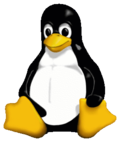The topic of this article may not meet Wikipedia's notability guideline for biographies .(November 2011) |
Larry Ewing | |
|---|---|
 Larry Ewing at LinuxTag 2007 in Berlin | |
| Occupation | Image designer |
| Spouse | Kristy Anderson |
| Children | Eva Ewing, Hazel Ewing |

Larry Ewing is an American computer programmer who is known as the creator of the Linux mascot, Tux. The artwork was created in 1996, [1] [2] [3] while Ewing was a student at Texas A&M University, originally as a submission for a contest to create the Linux logo. Though Ewing's submission didn't win, his artwork was adopted as the Linux "brand character". [4] [5] Ewing also created the Ximian and Mono monkey logos and is involved in:
- F-Spot: a project aiming to "manage all your digital photography needs."
- GtkHTML: a fast and dirty HTML renderer and editor used in several free software projects.
- Novell Evolution: a mailer, a calendar and a contact manager, all in one.
- GIMP: an image manipulation program.
- Moonlight: an open source implementation of Silverlight for Unix systems.
- Mimekit: A C# MIME creation and parser library with support for S/MIME, PGP, TNEF and Unix mbox spools.
- .NET Foundation: an independent organization, incorporated to improve open-source software development and collaboration around the .NET Framework.
He lives in Austin with his wife Kristy and his daughters Eva and Hazel.